Glossary

Glossary
Abhyasa
PracticeAham
Self; I AM.Ahimsa
Non-injury. Principle of non-violence towards everyone including animals. Ahimsa's precept of 'cause no injury' includes one's deeds, words, and thoughts.Ananda
Happiness; BlissAnandamaya
Blissful; Filled with Happiness.Annamaya
Made up of food; composed of food.Ardhanareeswara
Lord Shiva and Goddess Parvati in the form of half man and half woman united as one Being.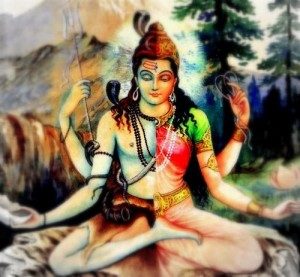
Arjuna
Arjuna was the 3rd of the Pandava brothers. He was a brave, triumphant warrior. He is considered as the protagonist of the Mahabharata with Krishna and plays a key role in the Bhagavad Geeta.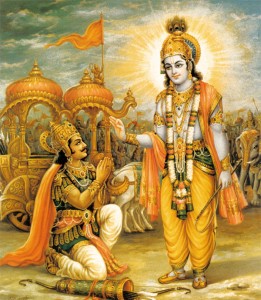
Asana
Posture; SeatingAshram
Traditionally, an ashram is a spiritual hermitage, a monastery, a monastic community, or a place of religious retreat for Hindus.

Ashramas
The four Ashramas are orders or stages of life. They are Brahmacharya (Youth/Bachelor - dedicated towards education and development of strong values), Grihastha (Householders - maintaining a good, happy family and being a good example for children and society), Vanaprastha (Retirement - having completed one's duties, taking to contemplation, guidance and peaceful activities), and Sannyasa (Renunciation - giving up attachment to worldly, material desires to achieve oneness of the soul with the supreme being).
Atman
Ātman is a Sanskrit word that means inner self or soul. In Hindu philosophy, especially in the Vedanta school of Hinduism, Ātman is the first principle, the true self of an individual beyond identification with phenomena, the essence of an individual. In order to attain liberation, a human being must acquire self-knowledge (atma jnana) which is to realize that one's true self (Ātman) is identical with the transcendent self Brahman.Avidya
Ignorance. Not Knowing one's true Self.Bhagavan
God; Lord. An enlightened Sage is considered God's incarnation, and so is many times called Bhagavan. ~~~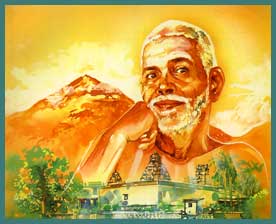
Bhajan
Devotional SongBrahmaakaara
Associated with Brahman, the True Self.Buddhism
The religion followed by the followers of Sri Gautama Buddha, an Enlightened Master or Sage of India.Caste
The four castes are Brahmana, Kshatriya, Vaisya and Sudra. This division is according to the Guna (Quality of Mind and Karma (Kind of Work done). Both Guna and Karma determine the caste of a man.
Sattwa is good, Rajas is passionately active, Tamas is dullness and inertia.
In a Brahmana, Sattwa predominates. He possesses serenity, purity, self-restraint, straightforwardness and devotion. In a Kshatriya, Rajas predominates. He possesses prowess, splendour, firmness, dexterity, generosity and rulership. In a Vaisya, Rajas predominates and and less of Tamas. He does the duty of ploughing, protection of cattle and trade. In a Sudra, Tamas predominates and less of Rajas. He is not capable of having the predominance of the above qualities.
chakshus
Look; Eyes.Darsan
Seeing the Form of a Divine Being - Sage or God
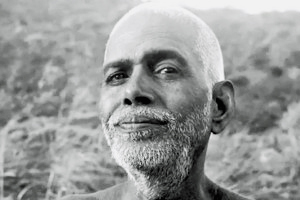
Diksha
Diksha is giving of a mantra or an initiation by the guru in Indian religions such as Hinduism, Buddhism, and Jainism. Diksha can be of various types, through the teacher's sight, touch, or word, with the purpose of purifying the disciple or student. Diksha (Sanskrit: दीक्षा in Devanagari, dīkṣā, Tamil: தீட்சை) also spelled deeksha or deeksa in common usage, is translated as a "preparation or consecration for a religious ceremony".Gunas
Guṇa, depending on the context means 'string, thread or strand', or 'virtue, merit, excellence', or 'quality, peculiarity, attribute, property'. There are three guṇas. They are called: sattva (goodness, constructive, harmonious), rajas (passion, active, confused), and tamas (darkness, destructive, chaotic). All of these three gunas are present in everyone and everything, it is the proportion that is different. The interplay of these gunas defines the character of someone or something, of nature and determines the progress of life. In some contexts, it may mean 'a subdivision, species, kind, quality', or an operational principle or tendency of something or someone. In human behavior, Guna means personality, innate nature and psychological attributes of an individual.Guru
Guru: a Teacher, Master, an Enlightened Being particularly in Indian religions. The Hindu guru-sishya (teacher-student) tradition is the oral tradition or religious doctrine or experiential wisdom transmitted from teacher to student. In the present times, Guru could mean anywhere from an expert in a certain field to a Spiritual Master.
Sri Ramana Maharshi
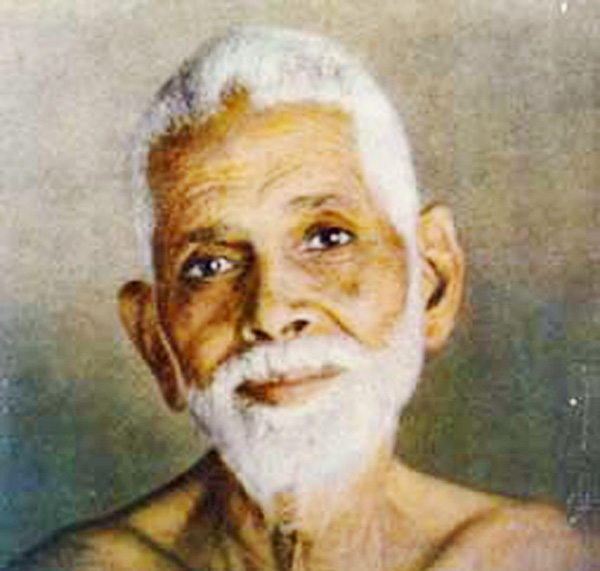
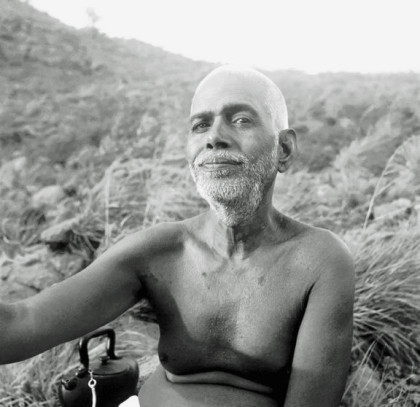
Homa
Worshipping by offering oblations into the consecrated fire.Hrimkara
The Self; the SourceJiva
Individual Self; soul; a person

Karma
Karma means action, work or deed. Karma also stands for the consequences of a mental or physical activity. In Hinduism and Buddhism, Karma denotes the sum of a person's actions in this and previous states of existence, viewed as deciding their fate in future existences. It refers to the spiritual principle of cause and effect where intent and actions of an individual (cause) influence the future of that individual (effect). Good intent and good deeds contribute to good karma and future happiness, while bad intent and bad deeds contribute to bad karma and future suffering.

Kosa
Sheath; Layer.Kripa
Grace; God's Grace; Guru Kripa is Guru's Grace.Manomaya
Made up of mind; composed of mind.Mantra
Mantra is (originally in Hinduism and Buddhism) a word or sound repeated to aid concentration in meditation. It can also be a Vedic hymn. Mantra is typically a word, statement or slogan repeated frequently. For example, AUM or OM (pronounced Ohm) is the original, divine Mantra in India. It stands for the Almighty that is the Beginning, Middle and End of all Beings.Mauna
Silence, Mental Silence, Inner Tranquillity

Maya
The Great Illusion that projects the world and veils our Real Self. To remove this illusion and realize one's Blissful, Immortal Nature, Self-Enquiry in the manner of "Who am I ?" becomes essential and the most effective and direct means.

OM
AUM (commonly known as OM) is the original, divine, sacred Mantra of India. It is composed of three sounds : A (ah) is the innermost sound produced from deep within the body, U (ooh) is the Middle sound produced somewhere in the throat area, and M (ihm) is the outermost sound produced at the lips. This denotes the Almighty Being as the Beginning, Middle and End of all beings. Therefore, chanting this Mantra, contemplating on its meaning or looking for the Source of the "I" who chants are considered the best and effective practices of Meditation.Prakriti
Nature. The primal matter with three different innate qualities (Guṇas:Qualities of Mind - Sattva:Good, Rajas:Passionate, Tamas:Dull) whose equilibrium is the basis of all observed empirical reality.
Pranayama
Pranayama in Hindu Yoga is the regulation of breath through certain techniques and exercises. It is a conscious prolongation of inhalation, retention and exhalation. 'Prana' pronounced 'Praanaa' is the Life Energy, both individual and universal. If breath is controlled, mind is controlled and becomes quiet and vice versa. It is used as an aid to meditation, relaxation, calming the mind and general health.
Rajas
Rajas is the force which promotes or upholds the activity of the other aspects of nature (prakriti) such as one or more of the following: action, change, mutation; passion, excitement; birth, creation, generation. If a person or thing tends to be extremely active, excitable, or passionate, that person or thing could be said to have a preponderance of rajas.
Ramanasramam
It is the Ashram of Sri Ramana Maharshi. He did not form or establish any organization. He was an enlightened Being, totally absorbed in the Self, living a simple life on the Holy Arunachala Hill without touching money, wearing a single cloth, without caring for his body. But later on, as people surrounded Him, the Ashram happened, and He lets things happen as ordained, for the benefit of others.

Sadhana
PracticeSadhu
In Sanskrit: Monk; Hermit; Renunciate.Sage
One who has attained Perfect Wisdom. An Enlightened, Self-Realized Being. Sri Ramana Maharshi
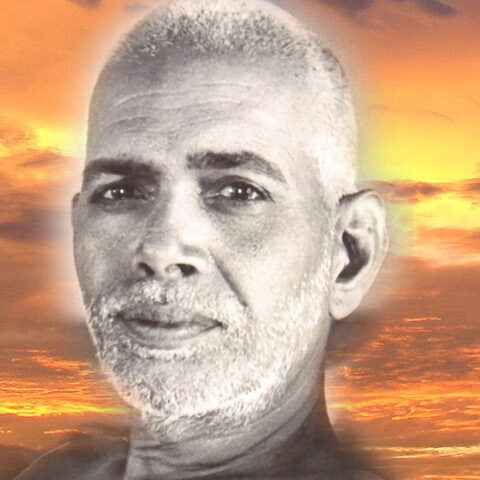
Sanatana Dharma
Sanatana Dharma is the Eternal Way of Life in India. In India, ancient Sages who researched within and discovered the Truths of one's Real Being, passed it on to their disciples, who in turn passed it on to others. There is really no such thing as "Hinduism". It is just a fusion of Indian Cultures and Traditions, with no Founder.
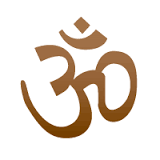 Aum or Om- Meaning: The All-Pervading Being which is the Beginning, Middle and End of all Beings
Aum or Om- Meaning: The All-Pervading Being which is the Beginning, Middle and End of all Beings  Hindu Swastika Symbol - Meaning: Well-Being, Good Fortune
Hindu Swastika Symbol - Meaning: Well-Being, Good FortuneSat
Being; Existence; Truth; Reality

Sat-Chit-Ananda
Existence, Consciousness, Bliss.Satsang
Association with the wise. Typically it means getting together with good, spiritually inclined people either for worshipping God, chanting, reading or singing songs. In a higher sense, it means keeping in touch with teachings of great Great Sages or Scriptures - reading, listening, pondering, contemplating or meditating. The highest Satsang is to keep in touch with the True Self, the inner Being.
Sattwa
Sattva is a state of mind in which the mind is steady, calm and peaceful. In Vedantic philosophy, it one of the three qualities of prakriti, or nature, which are passion (rajas) dullness or inertia (tamas) and goodness or purity (sattva).Sparsa
TouchTamas
Tamas is the lowest of the three Gunas (qualities - Sattwa, Rajas and Tamas). Tamas is a force which promotes darkness, dissolution, death, destruction, ignorance, sloth, and resistance.Thayumanavar
Thayumanavar or Tayumanavar, Tamil: தாயுமானவர் (1705–1742), pronounced Thāyum-ānavar, is one of the spiritual giants and a Tamil philosopher from Tamil Nadu, India. Thayumanavar's key teaching is to discipline the mind, control desires and meditate peacefully. He went on to say that "it is easy to control an elephant, catch hold of the tiger's tail, grab the snake and dance, dictate the angels, transmigrate into another body, walk on water or sit on the sea; but it is more difficult to control the mind and remain quiet".Tiruvachakam
Thiruvachakam (Tamil: திருவாசகம், lit. "sacred utterance") is a volume of Tamil hymns composed by the ninth century poet ManickaVachagar. It contains 51 compositions and constitutes the eighth volume of the Tirumurai, the sacred anthology of Tamil Saiva Siddhantha.
Legend has it that Manikkavasakar was appointed as minister by King Arimarttanar and sent to purchase 10,000 horses from Arab traders but spent the money building a temple in Tiruppanthurai.
Thiruvachakam is the only work which is signed by lord Siva.
Upadesa
Upadeśa (Sanskrit: उपदेश), "teaching," "instruction", is the spiritual guidance provided by a guru or spiritual teacher. The guru does not merely ask his disciple to perform a task; he helps him by remaining by his side and directing him, indeed remaining close to his heart and showing the pupil the path he must follow in this life.Vairagya
Dispassion; Non-attachment.Varnas
The original varnashrama is the division of society into four Varnas (types) and four Ashramas (stages of life) that cooperate to satisfy the Supreme Being. One's Varna is determined by one's character, qualities, training, and work. The focus is spiritual advancement and spiritual satisfaction for each member of society.
There are three qualities or Gunas : Sattva (purity), Rajas (passion) and Tamas (inertia). These three qualities are found in all people, but in varying proportions. Each Varna has these qualities in different amounts. One who has pure Sattva alone is a Sage. If Sattva predominates, they are contemplative, wise thinkers who guide rulers of the country, provide spiritual stability to the society, people with a pure mind and good, gentle qualities. If Rajas predominates, they are good, brave, but passionate and activity oriented people. If Tamas predominates, they are dull and ignorant, not prone to enquiry and reasoning.
Serenity, self-restraint, austerity, purity, forgiveness, uprightness, knowledge, faith in God, Self-Realization are the duties of the Brahmanas, born of (their own) nature. Prowess, splendour, firmness, dexterity, and also not fleeing from battle, generosity and lordliness are the duties of the Kshatriyas, born of (their own) nature. Agriculture, cattle-rearing, trade and business are the duties of the Vaisyas, born of (their own) nature. And other people performing their actions, professional or household, consisting of other services to the community is the duty of the Sudras, born of (their own) nature.
Vijnanamaya
Composed of Intellect, the analyzing, rationalizing entity.Vritti
Thinking; thought.Yagna
Yagna or Yajna literally means "sacrifice, devotion, worship, offering", and refers in Hinduism to any worship or ritual done in front of a sacred fire, often with mantras chanted. The tradition has evolved from offering oblations and libations into sacred fire, to symbolic offerings in the presence of sacred fire.
Yogi
The term "yogi" is used broadly to refer to a Sanyasi (Renunciate or Hermit) or practitioners of Meditation. A yogi is a practitioner of yoga. The term "yogi" is also used to refer specifically to Siddhas (accomplished ones, or one with supernatural powers).Yogic
Mental Contact; Mental Merging; Heart-to-Heart contact.Yogin
A yogi is a practitioner of yoga. The term "yogi" is used broadly to refer to a sannyasi (renunciate) or practitioners of meditation in India.








 Bhagavan Sri Ramana Maharshi
Bhagavan Sri Ramana Maharshi Great Scriptures of India
Great Scriptures of India Guidance Of Supreme Gurus
Guidance Of Supreme Gurus Recipes ~ Great Tasty Healthy
Recipes ~ Great Tasty Healthy Ramana Maharshi Podcasts
Ramana Maharshi Podcasts Sri Nisargadatta Maharaj Podcasts
Sri Nisargadatta Maharaj Podcasts Supreme Gurus Podcasts
Supreme Gurus Podcasts